New Mercury 150 FourStroke Outboard Debuts
Mercury talked to real boat owners, then designed a new 150 to be durable and easy to maintain.
If you start up the new Mercury 150 FourStroke outboard, the sound you’ll hear is the voice of the customer. This is a very important new model for Mercury. There are more new-boat models rated for a 150-hp motor than any other – in 2009 Mercury counted 550 of them, from pontoons to salt-water center consoles. The next-largest rating point is 115-hp, with 375 models.
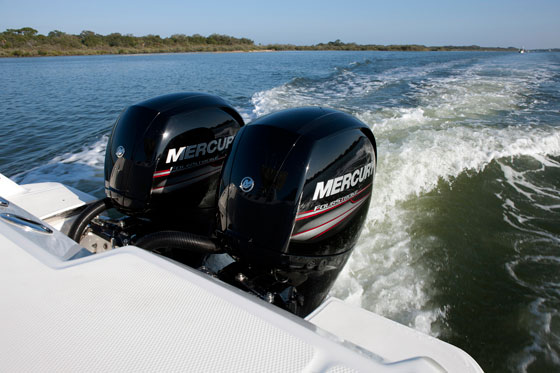 The new Mercury 150 FourStroke outboard was designed based on feedback from customers.
The new Mercury 150 FourStroke outboard was designed based on feedback from customers.
So when it started work on a new 150 in 2007, Mercury asked those boat owners what they wanted. The result is the new 150 FourStroke, a motor designed to be affordable, rugged, durable, easy to maintain, and especially adaptable to re-power applications.
Mercury already has two 150-hp models in its line, the super-charged four-stroke Verado 150, and the direct-injection two-stroke OptiMax 150. But the 510-pound Verado is heavy for the class, and it requires a SmartCraft DTS digital control that costs $1,326, more than twice as much as standard cable controls.
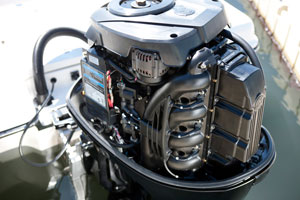 Exhaust manifold has free-flowing runners and is positioned to keep heat away from the engine. Composite valve cover saves weight.
Exhaust manifold has free-flowing runners and is positioned to keep heat away from the engine. Composite valve cover saves weight.
The DTS control is an issue for an owner looking to repower an older boat already equipped with a Merc outboard, and these days that’s a big part of the market. The OptiMax is a less-expensive alternative, but it’s a larger V6 and many boaters just don’t want a two-stroke.
What’s Different
With a suggested retail price of $12,980, the 150 FourStroke slots between the Verado ($13,900) and the OptiMax ($12,500), and is significantly less expensive than the Yamaha F150 ($15,530), which in many markets is the best-selling 150 and was a benchmark for Mercury.
Like all the competing 150 four-stroke models, the Mercury has a four-cylinder powerhead. Its 3.0-liter displacement is 12 percent more than the 2.7-liter Yamaha and larger than any in the class, and at 455 pounds it’s the lightest four-stroke 150 by at least 19 pounds.
Mercury says that robust displacement enhances durability, because the motor can almost loaf along and still make competitive power, which in this class is really 164.9 horsepower, not 150. It has a single overhead camshaft driven by a chain running in an oil bath below the powerhead with maintenance-free, automatic tension adjustment. All other 150 four-strokes have a double overhead cam valve train with four valves per cylinder.
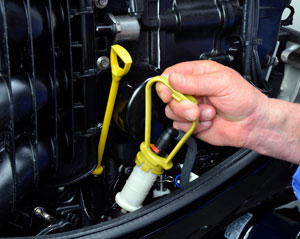 Handle and quick-connect hose fittings ease fuel filter service.
Handle and quick-connect hose fittings ease fuel filter service.
Merc says its single cam and two-valve head is lighter, more compact and less complex than a DOHC design. The valves are actuated with finger roller followers that reduce friction and require no valve lash adjustment. To accommodate stronger (but not larger) gears, the gearcase housing is 4.9 inches in diameter, .25-inch larger than the OptiMax case.
The new motor also has an integral oil cooler. A free-flowing, die-cast exhaust header bypasses the adapter plate, so less heat is passed back into engine oil and coolant. Finally, the mounting system is unusual; the top mounts are splayed at a 45 degree angle, which Merc says improves vibration isolation and also moves the rubber mounts away from engine heat, so they will last longer.
Customers also said they value compact size and light weight in a four-stroke 150. Anglers especially appreciate having to work around less motor on the transom. The single-cam head reduces the size of the powerhead compared to the competition.
And Merc got clever when it rotated the powerhead 11 degrees to port, so it fits more neatly into the corners of the pan and cowl. Twisting the powerhead created space in the aft starboard corner for a compact, scroll-shaped intake manifold. And rather than form the cowl as a one-piece “bucket,” Mercury bonds together multiple parts formed in lightweight composite to create a cowl that is more compact, because the bottom does not have to be the largest dimension.
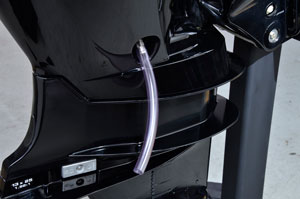 Oil drain fitting accepts a hose and opens with a half-turn. Oil can also be sucked out through the dipstick tube.
Oil drain fitting accepts a hose and opens with a half-turn. Oil can also be sucked out through the dipstick tube.
All this adds up to less “tilt arc and transom well intrusion” than the 150 FourStroke’s competition, according to Mercury. On the water, it looks smaller than either the 115 FourStroke or the 150 Verado.
Easier Maintenance
More than some other boaters, 150 owners tend to do their own maintenance, according to Merc. It also knows we do not read the owner’s manual, so it put key maintenance and service info on a sticker that’s plastered right on the cover of the electrical system on the powerhead. There will also be a “QR” symbol that can be scanned with a smart phone to link to videos, demonstrating how to change the oil, for example.
That annual task is made easier and less messy by a new oil-drain fitting with a nipple for a hose (so you can route it to a disposal container). The fitting opens with a half-turn of a wrench, like a brake-bleeder fitting.
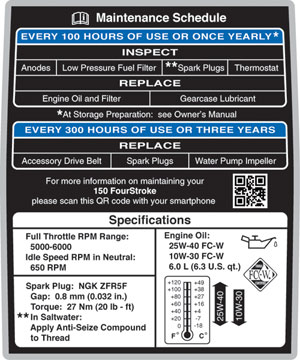 Large label puts basic maintenance info right on the motor, with a QR symbol to connect a smart phone to how-to videos.
Large label puts basic maintenance info right on the motor, with a QR symbol to connect a smart phone to how-to videos.
You can slip that same hose over a nipple in the bottom of a catch-tray under the oil filter. A handle makes it easy to fish the fuel filter up from the pan, and quick-disconnect fittings make it literally a snap to change without tools. This motor is permanently lubed – there are no grease fittings to service. If you are willing to change the gearcase lube, you can handle your own annual service. Just watch the video first.
Running
I spent about a half-hour on the water with a 150 FourStroke rigged to a well-worn Lund 1800 Fisherman from the Merc test facility in Oshkosh, Wis. This motor is super-quiet at idle, thanks to a new muffler device on the exhaust relief. Water lapping the hull makes more noise.
Even at planing speeds, the 150 FourStroke is so quiet I could talk in a normal voice with the motor humming just a few feet away. With three full-grown men on board, the boat popped right on plane, and pulled a 16-pitch Enertia prop to 5800 rpm.
Merc asked me not to report speed or fuel use as this was a pre-production motor. I just ran a Verado 150 on a similar-size Crestliner, and my highly-calibrated, seat-of-the-pants comparison is that the 150 FourStroke can match the performance of the Verado in all regards except perhaps for mid-range acceleration, where the Verado supercharger delivers some nice punch. Which is not to say the 150 FourStroke is lacking. It’s just no Verado.
The 150 FourStroke will be in production late this year and begin to reach dealers and boat builders before January 2012. DTS is not an option for this motor, but boats with dual 150 FourStroke engines can be rigged with the same power steering system offered with Verado motors. It can also be fitted with the Mercury Big Tiller with power-assist if you are so inclined.
If the customers are really always right, they should love this motor.
For more information, visit Mercury Marine.
Mercury talked to real boat owners, then designed a new 150 to be durable and easy to maintain.
If you start up the new Mercury 150 FourStroke outboard, the sound you’ll hear is the voice of the customer. This is a very important new model for Mercury. There are more new-boat models rated for a 150-hp motor than any other – in 2009 Mercury counted 550 of them, from pontoons to salt-water center consoles. The next-largest rating point is 115-hp, with 375 models.

So when it started work on a new 150 in 2007, Mercury asked those boat owners what they wanted. The result is the new 150 FourStroke, a motor designed to be affordable, rugged, durable, easy to maintain, and especially adaptable to re-power applications.
Mercury already has two 150-hp models in its line, the super-charged four-stroke Verado 150, and the direct-injection two-stroke OptiMax 150. But the 510-pound Verado is heavy for the class, and it requires a SmartCraft DTS digital control that costs $1,326, more than twice as much as standard cable controls.

The DTS control is an issue for an owner looking to repower an older boat already equipped with a Merc outboard, and these days that’s a big part of the market. The OptiMax is a less-expensive alternative, but it’s a larger V6 and many boaters just don’t want a two-stroke.
What’s Different
With a suggested retail price of $12,980, the 150 FourStroke slots between the Verado ($13,900) and the OptiMax ($12,500), and is significantly less expensive than the Yamaha F150 ($15,530), which in many markets is the best-selling 150 and was a benchmark for Mercury.
Like all the competing 150 four-stroke models, the Mercury has a four-cylinder powerhead. Its 3.0-liter displacement is 12 percent more than the 2.7-liter Yamaha and larger than any in the class, and at 455 pounds it’s the lightest four-stroke 150 by at least 19 pounds.
Mercury says that robust displacement enhances durability, because the motor can almost loaf along and still make competitive power, which in this class is really 164.9 horsepower, not 150. It has a single overhead camshaft driven by a chain running in an oil bath below the powerhead with maintenance-free, automatic tension adjustment. All other 150 four-strokes have a double overhead cam valve train with four valves per cylinder.

Merc says its single cam and two-valve head is lighter, more compact and less complex than a DOHC design. The valves are actuated with finger roller followers that reduce friction and require no valve lash adjustment. To accommodate stronger (but not larger) gears, the gearcase housing is 4.9 inches in diameter, .25-inch larger than the OptiMax case.
The new motor also has an integral oil cooler. A free-flowing, die-cast exhaust header bypasses the adapter plate, so less heat is passed back into engine oil and coolant. Finally, the mounting system is unusual; the top mounts are splayed at a 45 degree angle, which Merc says improves vibration isolation and also moves the rubber mounts away from engine heat, so they will last longer.
Customers also said they value compact size and light weight in a four-stroke 150. Anglers especially appreciate having to work around less motor on the transom. The single-cam head reduces the size of the powerhead compared to the competition.
And Merc got clever when it rotated the powerhead 11 degrees to port, so it fits more neatly into the corners of the pan and cowl. Twisting the powerhead created space in the aft starboard corner for a compact, scroll-shaped intake manifold. And rather than form the cowl as a one-piece “bucket,” Mercury bonds together multiple parts formed in lightweight composite to create a cowl that is more compact, because the bottom does not have to be the largest dimension.

All this adds up to less “tilt arc and transom well intrusion” than the 150 FourStroke’s competition, according to Mercury. On the water, it looks smaller than either the 115 FourStroke or the 150 Verado.
Easier Maintenance
More than some other boaters, 150 owners tend to do their own maintenance, according to Merc. It also knows we do not read the owner’s manual, so it put key maintenance and service info on a sticker that’s plastered right on the cover of the electrical system on the powerhead. There will also be a “QR” symbol that can be scanned with a smart phone to link to videos, demonstrating how to change the oil, for example.
That annual task is made easier and less messy by a new oil-drain fitting with a nipple for a hose (so you can route it to a disposal container). The fitting opens with a half-turn of a wrench, like a brake-bleeder fitting.

You can slip that same hose over a nipple in the bottom of a catch-tray under the oil filter. A handle makes it easy to fish the fuel filter up from the pan, and quick-disconnect fittings make it literally a snap to change without tools. This motor is permanently lubed – there are no grease fittings to service. If you are willing to change the gearcase lube, you can handle your own annual service. Just watch the video first.
Running
I spent about a half-hour on the water with a 150 FourStroke rigged to a well-worn Lund 1800 Fisherman from the Merc test facility in Oshkosh, Wis. This motor is super-quiet at idle, thanks to a new muffler device on the exhaust relief. Water lapping the hull makes more noise.
Even at planing speeds, the 150 FourStroke is so quiet I could talk in a normal voice with the motor humming just a few feet away. With three full-grown men on board, the boat popped right on plane, and pulled a 16-pitch Enertia prop to 5800 rpm.
Merc asked me not to report speed or fuel use as this was a pre-production motor. I just ran a Verado 150 on a similar-size Crestliner, and my highly-calibrated, seat-of-the-pants comparison is that the 150 FourStroke can match the performance of the Verado in all regards except perhaps for mid-range acceleration, where the Verado supercharger delivers some nice punch. Which is not to say the 150 FourStroke is lacking. It’s just no Verado.
The 150 FourStroke will be in production late this year and begin to reach dealers and boat builders before January 2012. DTS is not an option for this motor, but boats with dual 150 FourStroke engines can be rigged with the same power steering system offered with Verado motors. It can also be fitted with the Mercury Big Tiller with power-assist if you are so inclined.
If the customers are really always right, they should love this motor.
For more information, visit Mercury Marine.

